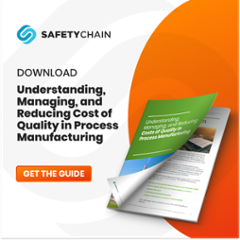

Quality assurance plays an important role in any industry. It helps companies consistently deliver safe and consistent products to end-users, and is therefore essential to business performance. For the food and beverage industry, in particular, a commitment to quality is a paramount area of focus, as their end-users directly consume the goods and products they produce and package. Of course, there are also various levels of the supply chain in-between, and overlooking quality at any one of these steps could compromise an organization's brand reputation and customer relationships. This guide to best practices for quality assurance provides a framework for food manufacturers to have a better understanding of what best practices are essential to food quality.
Quality assurance encompasses a broad set of activities to prevent defects proactively. It is an ongoing effort – not a one-time activity – and must therefore be practiced every day to achieve the desired outcomes on an ongoing basis. Here, we take a look at some of the essential quality assurance best practices for the food industry that can be used by companies of all sizes and types of operation.
Every effective quality assurance program is built on a strong set of expectations. In order to implement activities that will be used to achieve consistent products within specifications, you must first define those specifications. Which metrics will guide and determine quality in your facility?
To answer this question, many companies must take a step back and consider the cost of quality. The cost encompasses both the costs of poor quality, including internal and external failure costs, as well as the costs of good quality, which encompass appraisal and prevention costs. In general, it is recommended that costs of poor quality should not exceed 10-15% of revenue in a thriving company. This can work as a solid starting point for constructing an overarching framework of quality expectations: reducing the costs of quality without compromising performance.
In addition to cost considerations, food and beverage companies must proactively establish a strong foundation to address the quality – and safety – of their products. This foundation should encompass quality metrics, identified risks, and mitigation strategies for addressing those risks. Each of these factors is explored in this guide in greater detail below.
Quality metrics can come from a number of sources. In some cases, they may be defined by customer requirements. In others, quality certifications like those from the Safe Quality Food Institute (SQF), a GFSI-recognized scheme, may play a role in dictating a facility’s approach to quality parameters.
The success of a quality assurance program depends largely on setting realistic expectations. Product specifications, both internally and from the customer, should be attainable given the resources the facility has available. When a company is confident in their ability to deliver products or materials within their customer’s specifications from the start, their risks of facing quality-related issues are greatly reduced. Suppliers and purchasing companies must therefore be thorough and precise when reviewing contracts to ensure expectations are clear for both parties.
Specifications identified by customers should serve as the starting point for identifying critical quality points in a documented quality process control plan. There is a broad range of quality metrics food companies may track, including temperature, humidity, and pH levels, to name just a few.

The food and beverage industry faces a number of inherent risks. There are also site-specific risks, as well as those associated with certain products. Food products containing allergens, for example, leave facilities vulnerable to an entire host of risks, including cross-contact and labeling issues. To support a strong quality assurance program, companies should perform a detailed risk assessment, analyzing potential risks across all possible areas. After risks are identified, they can be ranked (high, moderate, and low) to form an actionable mitigation plan.
To conduct a thorough risk assessment, companies should evaluate all of the major areas of their food quality systems. Potential areas to analyze could include suppliers, raw materials, crisis management, product recalls, audit management, traceability, allergens, complaints, sanitation, and microbial control. This list is by no means exhaustive, and it is important to perform site-by-site assessments to identify the specific risks present at each location.
Once risks have been identified, companies can establish a Quality Process Control System through which mitigation strategies will be implemented. It can follow a framework similar to that of HACCP methodology: use existing product descriptions and flow charts, performing a Quality Risk Analysis to determine threats and identify Critical Quality Points (CQP)s.
After establishing CQPs, the next steps include identifying procedures for operating limits, monitoring, corrective actions, verification, and record-keeping. This approach mirrors the SQF Food Quality Plan but is focused on CQPs for performance correlated with specifications. With that said, it is not limited for use in GFSI-certified facilities alone, and its benefits can be realized in any food or beverage manufacturing or packaging facility.
Mitigation strategies should be structured to address the highest-level risks proactively. Their purpose is to help you control deviations and achieve proactive defect prevention. Activities should include developing Quality Standard Operating Procedures (SOPs) and providing effective training for QA teams to satisfy quality demands on an ongoing basis. All policies and procedures should be thoroughly documented for compliance purposes.
Quality assurance is crucial for food processors to ensure the safety, integrity, and consistency of their products. Implementing effective quality standard operating procedures (SOPs) is essential to meet regulatory requirements, maintain customer satisfaction, and protect brand reputation. In this section, we will discuss the essential SOPs that food processors should consider implementing to uphold high-quality standards in their operations.
Implementing these essential quality standard operating procedures is fundamental for food processors to ensure product safety, consistency, and compliance. By adhering to robust SOPs, food processors can safeguard their brand reputation, meet customer expectations, and contribute to a safer and more reliable food supply chain. Regular training, monitoring, and continuous improvement are vital to ensure the effectiveness and efficiency of these procedures.
Clear and thorough quality expectations pave the way for effective execution. To achieve quality assurance on an everyday basis, companies use processes like Statistical Process Control (SPC) monitoring, among other quality improvement activities.
SPC monitoring measures and controls quality by comparing products against pre-established quality parameters. When completed in real-time, SPC monitoring allows QA teams to spot and address deviations promptly, before more products can become affected. This helps to reduce waste, thereby not only controlling quality output but also minimizing reworks, non-conformances, and costs.
In addition to SPC monitoring, tactics such as corrective actions must be implemented for instances in which results fall out of specification. Sampling and grading programs, finished product testing, and pre-shipment reviews are also tactics that can be used – and through modern tools, automated – to control quality.
To learn more about the importance of statistical process control — and how much money it can save your company — read this informative blog.
Of course, it isn’t enough to simply perform SPC monitoring or other forms of quality control. To make sure tactics are actually working to improve quality performance, you must collect and analyze relevant data. Traditionally, food and beverage companies performed data collection manually. Paper-based systems and even offline tools like spreadsheets were used to formulate graphs and charts depicting quality performance measures. Recently, however, the industry has seen a shift with the development of quality assurance software. Software provides mobile data tools and real-time analytics, featuring dashboards and up-to-the-moment insights across every shift. This achieves automated data collection and ongoing visibility into quality assurance on an ongoing basis. Learn more about justifying a switch from paper to a Quality Management System here.
In addition to simply collecting data, QA teams must measure relevant information, identifying cause and effect relationships. In doing so, they can draw clear conclusions about bottlenecks in production and across the supply chain. Patterns can be identified not only in quality metrics such as temperature, size, fill level, and other product parameters, but also across broader performance indicators including a number of complaints, downtime, and overall equipment effectiveness. Ultimately, it is not just the quality data itself but the meaning derived from it that allows food and beverage facilities to unlock the true business potential behind everyday quality assurance efforts.
The final – yet critically important – piece of the quality assurance puzzle is using the data generated in operations to drive continuous improvement. This means that in addition to monitoring performance on a shift-by-shift, day-by-day basis, companies should also look at aggregate performance over a long-term basis. Findings can then be used to drive strategic business decision-making.
Utilizing the data gathered from operations, you can uncover inefficiencies and recurring issues. Supplier performance and equipment performance, for instance, can shed insights into areas for improvement that could help reduce your costs of quality and rates of on-time customer shipments. Over time, it is also recommended that companies track key metrics such as product defects, waste, and a number of corrective actions for a comprehensive overview of performance.
This information can then be used to inform both short- and long-term goals. Using these insights, companies can continually drive success by structuring their priorities around the key quality outcomes that need to be addressed to realize the most significant resource savings and improvements in performance.
Quality assurance is by no means a simple endeavor. Yet, it is an essential component for ongoing success in any business, and especially those within the food and beverage industry. It is not a one-time event; instead, it must be approached as a series of ongoing activities, or a rhythm consisting of routinely revisiting quality expectations by assessing new risks as they arise, defining quality metrics, implementing mitigation strategies, and measuring performance. Once this rhythm is developed and refined, the pattern of ongoing improvement becomes achievable.